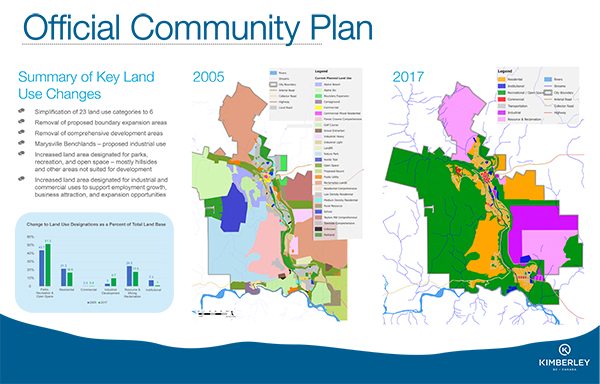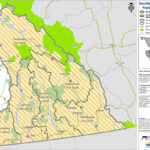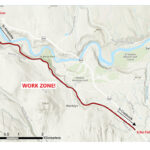Home »

Benchland industrial designation process approved
By Nowell Berg
Dozens of Marysville residents were in attendance at the City of Kimberley council meeting Oct. 23 – there to hear council’s debate Mayor Don McCormick’s motion “that the city-owned property known as the Marysville benchlands be designated for industrial development in the draft OCP (official community plan).”
During the Oct. 10 council meeting, Noah Wesche, founding partner of Sullivan Machine Works (SMW), presented a plan to relocate the clean-tech manufacturing facility to Kimberley from Calgary. He had identified the benchlands as the ideal location on which to locate the building.
Even before that meeting, misinformation, innuendo and rumours poured forth swirling around Marysville and the city. City staff and councillors received numerous phone calls and emails urging the city to preserve the benchlands as a natural green space and not allow any industrial development.

Mayor McCormick’s opening remarks clarified the intent of his motion, which was to provide city staff with direction on completing the first draft of the OCP (Official Community Plan). He reiterated the council meeting was not going to finalize any decision on the benchlands, but simply provide direction to staff regarding the OCP.
Troy Pollock, City manager of Planning Services, outlined the OCP process to-date and then presented a map showing the current land use designation, based on the 2005 OCP, for the whole of Kimberley and the proposed changes to land use designation for the new OCP, including the benchland. He stated the purpose of the OCP was to provide a “clear concise plan for development” within the city.
The new OCP would reduce the number of land use designations from 27 to seven and allow industrial development on the benchland.
Pollock pointed out the city would probably not allow heavy industrial development on the land as it was not in alignment with the city’s strategic goals. He said it would only be light industrial development.
The next steps in the OCP process, as outlined by Pollock, would be for a draft OCP to be presented to council for first reading which would then trigger a public hearing. He reiterated that nothing would be done about the benchland until the OCP process was complete and adopted by council. Only at that time could the city entertain proposals to buy or lease the land. At that point, any proponent would have to secure a development permit along with a building permit, which would require the city to obtain input from residents and stakeholders. This whole process could take two years before any development on the benchland would happen.

Coun. Sandra Roberts was first to ask Pollock, “Is it [the benchland] an industrial zone?”
Pollock stated “yes” the benchland was designated “industrial” in 1994. Then, and this is where it gets confusing, the 2005 OCP changed the benchland use designation to “residential.” However, since then the actual zoning of the benchland was never changed by council to match the land use designation.
Coun. Albert Hoglund asked Pollock, “Would the 2005 OCP overrule the 1994 bylaw?”
Pollock said “yes” it would if there was a proposal to purchase the property for residential development. He stated later the City had never received a proposal for residential development on the benchland.
Saying it was a “terrible motion” and was “out of order as it usurps the residential designation,” Hoglund suggested the OCP process continue and let it play out.

Next up, Coun. Bev Middlebrook reiterated her opposition to the land use change for the benchland. She told council the whole situation was “confusing for council and residents,” saying it was a “last minute switch.”
Middlebrook pointed out the motion was “tough on our [council’s] credibility.” She also asked if it was not best practices to keep residential and industrial land in separate areas.
Pollock stated this was “not a last minute change” of the land use designation, and in fact, had been “discussed in the past.”
He continued saying “the modern world was changing rapidly” and that “mixed use zoning” was the new norm as people want to live and work within close proximity. He pointed out that Kimberley already has mixed use zoning in the downtown and C-1 zone that allows commercial uses mixed with residential use.
Mayor McCormick asked Pollock: “What options for industrial space does the city have?”
Saying there were “very little” options in Kimberley and most of them were in Marysville, Pollock added the Teck lands, former site of the Sullivan Mine, would be years away from receiving environmental clearance from the province, if ever, which would render the land unusable in the foreseeable future.
McCormick also asked if there is any city-owned land that is feasible for light industrial development. Pollock replied, “The only suitable land for industrial development the city owns is benchland.”
Roberts spoke about the need for “clean industry” in Kimberley that would lead to the “diversification” of the economy. She lamented the “fickle” nature of tourism saying that any downturn in Alberta is cause for concern in Kimberley, thus the need for light industrial development. Given the city has “no land” and its “hands are tied,” if there is land that can help with diversification, then “I will go for it.” She ended by saying the OCP and development process is “insurance” for Marysville residents against any quick decisions.

Confused as to why the Mayor’s motion came out now, Coun. Kent Goodwin said the “OCP says what it says.” The Mayor’s motion has “people upset at this stage; there are many steps to go.” He was also concerned about the trail (Volksmarch) that travels along beside Jim Ogilvie Way remaining in place if the benchland was designated for light industrial use.
The Mayor indicated the trail would remain and its placement within the proposed new green space would be “up to the [city] planner.” He added the goal of his motion was to “provide direction to the Planning Department.” He argued the draft OCP needs to be presented to council for first reading, which would start the public hearing process. The OCP is a legislated requirement the city must complete. Only the content was up to residents, the city and council.
The Mayor asked Pollock when the draft OCP would go before council. Pollock said it was his intent to make that happen “before Christmas.”

Listening to all of the discussion and comments, Coun. Daryll Oakley finally weighed in. He raised four items. First, he wants the OCP process to continue and “appreciated the emails and phone calls” from residents, saying, “Keep them coming.”
Second, he noted that Kimberley has the highest residential property tax in all of the East Kootenay. To keep them from increasing each year, the city needs additional sources of tax revenue that would most likely come from industrial development. Third, the city didn’t have any options for designating industrial land because the contaminated Teck lands would probably never receive an environmental certificate from the Provincial government. Lastly, he said the city was “not moving fast enough” on designating industrial land. He said that other municipalities were “talking with SMW and I’d hate to lose them.”

Coun. Nigel Kitto said, “People are aware of the OCP process.” He continued, “Tonight is not the place to argue the pros or cons of the proposed OCP.” He acknowledged Marysville residents concerns over the benchland and urged them to continue to participate in the OCP process. He said, “Your emails are being read.” He urged residents to continue making their views known, one way or the other.
Mayor McCormick summed up his position saying that industrial development brings up “old images” of smoke stacks and pollution, which is not unlike what Cominco left behind at the old Sullivan Mine. He added that the SMW facility is clean-tech with none of the environmental baggage from the past.
The Mayor also pointed out that the CKDI (Cranbrook Kimberley Development Initiative) will be spending $500,000 over the next four years to attract business to the area. He said the first question businesses ask, when considering to relocate is, “What about land?” Without light industrial land available, Kimberley would not be able to benefit from the CKDI campaign.
Finally, the Mayor said the OCP process “must be in the best interests of the whole community.” The OCP process gathers input from all residents and stakeholders, measures competing interests and then council makes a decision for the entire community. “No one is here to screw you,” he stated. He also noted it wasn’t in the best interests of the whole city for council to “pit one neighbourhood against another.”

Taking a last stab at defeating the Mayor’s motion, Middlebrook said, “We need business. [But] people are afraid [the benchland] will be destroyed.” She speculated about what might happen if the business “didn’t work,” then the land would sit there with an empty building. She concluded, “Marysville is a quiet neighbourhood,” having an industrial park above the residential area would harm that tranquility.
At that, the Mayor called for a formal vote. Four councillors raised hands in favour – Roberts, Kitto, Oakley and Goodwin – and two opposed – Middlebrook and Hoglund. The motion passed.
The outcome won’t be known for many months and will surely create an interesting debate at the next OCP public hearing.
An interview with SMW founding partner Noah Wesche

After the council meeting, I had a chance to interview Noah Weshce about the benchland and Sullivan Machine Works.
First, I asked him about the backlash from Marysville residents. Was he surprised by it?
“Well no, Kimberley people are quite passionate. There is a lot of misinformation by a councillor who claims to represent Marysville. I think if they have the real facts and we don’t make fear based decisions, I think everything will work out fine,” he said.
He added, “I’m a big believer in having public conversation as long as it remains healthy.”
He’s okay that so far the issue has become controversial “because it makes people aware of what the real issues are.
“The real issue is not Sullivan Machine Works at the bench. The real issue is the environmentally contaminated land all around us that we can’t use.”
What’s it all about then? “Its not about my business at this point, its about a community discussion. I’m doing this because I think its the right thing to do for the community whether I get the land or not.”
Are there Kimberley residents who support the benchland being used for light industrial development and the SMW project?
“I know a lot of people who support it, and the fact that I am from Kimberley and not this ‘scary developer Calgary guy’ that I’m made out to be, when people realize that, the energy deescalates big time.”
Have you been contacted by other municipalities? “A lot, lots of economic development people, a lot of other business clusters that are interested and a lot of clean-tech energy companies have contacted me.
“The one that surprised me the most was actually Canal Flats, [they want to] turn it into a manufacturing cluster. They were one of the first to contact me. Give a shout out to Canal Flats; they have their head in the right space.”
At this time, Wesche is not even looking at other locations. He’s being positive that it will all work out in Kimberley.
“I am from Kimberley and know and love a lot of people in Marysville. I want to create something all of Kimberley can be proud of,” he said.
Lead image: A packed City of Kimberley council chambers on Oct. 23. Nowell Berg Photo
e-KNOW







